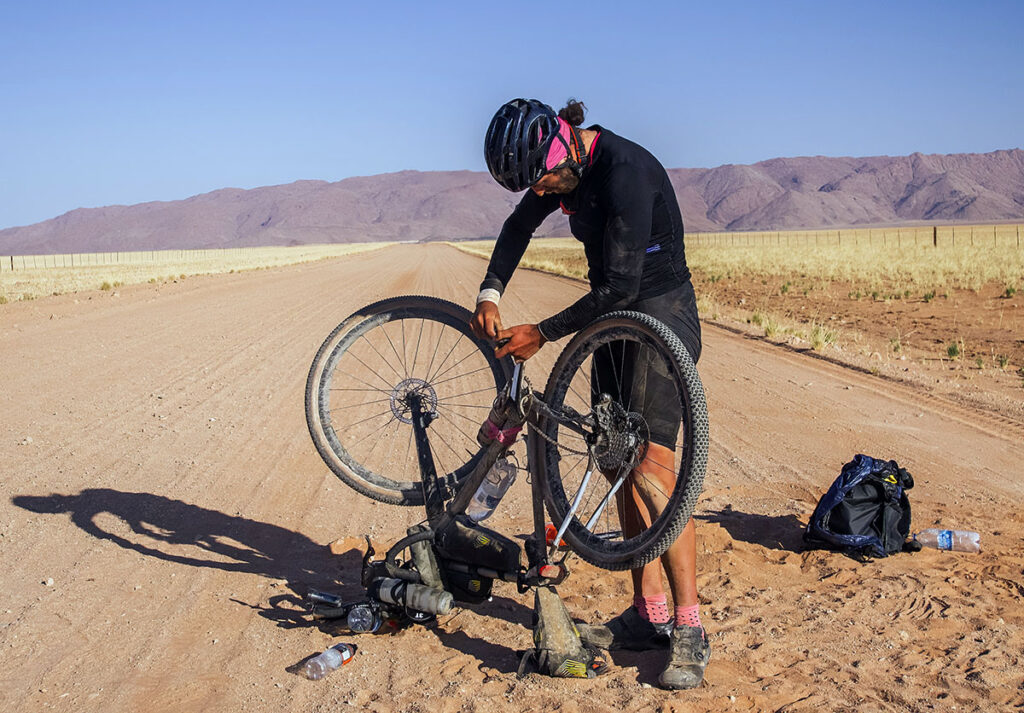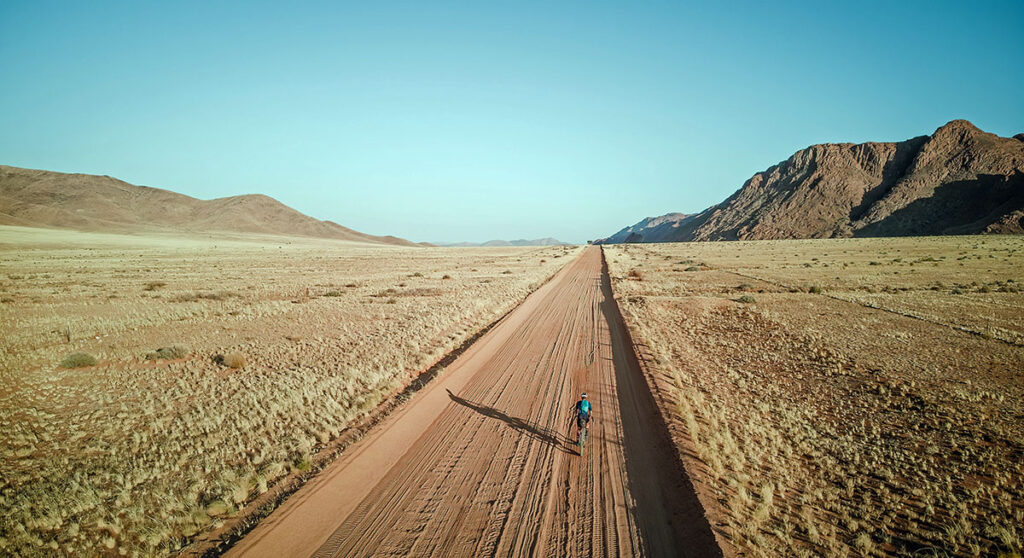Abdullah’s Bike for the Rhino Run
Last year’s bikepacking races saw some incredible competition. Sofiane Sehili won the Silk Road Mountain Race from James Hayden by less than an hour. Even more suspenseful was the Rhino Run, the race across the Karoo and Namib deserts of southern Africa. For almost eight days and 2,750 kilometers, Kevin (Benky) Benkenstein and Abdullah Zeinab raced neck-to-neck, often riding within sight. After a final showdown on the long climbs into the Namibia highlands, Abdullah won the race by just 17 minutes.
Abdullah wrote about his experience in the Spring 2023 Bicycle Quarterly. Photos of the majestic landscapes of South Africa and Namibia form a fitting backdrop for Abdullah’s epic adventure. His story is one of my favorite pieces of cycling writing—a roller-coaster ride of emotions during a race where almost anything that could go wrong did go wrong. Until everything came together in a rousing finale.
What Abdullah didn’t talk about much was his bike and equipment for the vast distances and rough roads, so we used the opportunity to catch up with him for this interview:

JH: Congratulations on your amazing win in the Rhino Run. What a race! We’ve enjoyed your story of the ride across 2,750 km of South Africa and Namibia in Bicycle Quarterly. But what everybody is curious about, is the bike you rode.
AZ: The bike is a Curve GXR with a Campagnolo Ekar groupset.
JH: Is that the same bike you used for training, or is it new for this event?
AZ: I used the same bike for training as I did for the event. I had a time trial bike on the trainer which I would sometimes ride but 99 percent of training was done on the bike I raced on.
JH: How did the work on those rough roads?
AZ: The bike worked awesome. I’m actually surprised it didn’t fall apart. I had several crashes and, apart from a bent derailleur hanger, everything survived without problems. I was nervous that I would have issues with the Ekar, as it’s a 1x group set. I was afraid I would have to find a mechanic to adjust it along the route. I didn’t end up adjusting the gears once, and it shifted the exact same as it did at the start.

JH: Tell us about the bent hanger. There’s the famous photo of you searching the desert for a tiny screw. What happened?
AZ: In the early hours of the seventh day, I hit a patch of sand and went flying over the handlebars. I was fine, but my derailleur hanger was bent. I decided to ride with the bent hanger until daybreak, then change it. That meant using only my biggest gears so the chain didn’t go into the spokes, but it was better than trying to change the hanger in the dark night. When I did change the hanger, there was a tiny grub screw that I needed to transfer from the old hanger to the new one. I dropped that screw.
JH: What happened then?
AZ: Finding that tiny screw in the vast desert of Namibia was hopeless. I searched for a long time. I divided the ground into squares, so I wouldn’t search the same place again and again. But I couldn’t find the screw.
JH: But you finished the race…
AZ: Once I gave up looking for that screw, I tried to find another screw on my bike that might work. I tried to take a screw out of my pedal, but it didn’t come out. Then I discovered a similar screw on my computer mount. I used that to attach my new derailleur hanger, and then I was on my way again.

JH: What about tires? Which tires did you run?
AZ: I ran Rene Herse Oracle Ridge 48mm tires.
JH: How did you select the tires?
AZ: I had no experience with gravel tires, so I asked a trusted friend what I should use. He told me that the Oracle Ridge 48 mm with the Endurance casing would be best, as it would be a fast and most durable tire for the event.
JH: How did the tires hold up over those thousands of kilometers of rocky and sandy roads?
AZ: The tires held up great. I got just one puncture, and that would have sealed if I didn’t touch it. But I had never had a flat on a tubeless tyre before, so I decided to plug it, which ended up making the hole bigger. Apart from that, there were no tire issues at all. I was pleasantly surprised as I had anticipated more issues, since my riding style can be quite rough.

JH: With hindsight, what would you do differently if you were entering the Rhino Run again?
AZ: The biggest change would be to make sure I did training on gravel prior to the event. Having to get used to gravel whilst simultaneously trying to race was a huge challenge. It made the race more stressful than it needed to be. From an equipment standpoint, I would use a dynamo hub so I wouldn’t need to worry about charging my lights. Some sections of the course are extremely remote, where you don’t have access to power to charge your devices. Another aspect of it is time. Having to stop to charge your devices can take quite a bit of time. Lastly I would use a wider tyre to accommodate for the rough terrain and make it more comfortable.

JH: The Namib Desert is one of the least populated places on earth, with vast distances between towns. And you were racing Kevin Benkenstein (above) day after day. On the road, what was the hardest part physically? And mentally?
AZ: For me it is a blend of the two. Some days, it’s a mental struggle. Other days, the physical fatigue is the biggest battle. For the first couple of days, the body holds up okay, but after that physical fatigue becomes a big factor. It’s amazing what the body can handle. You can be in absolute pain for half a day, and then suddenly the pain disappears. One of the biggest things I learnt is not to get too caught up in it, because chances are, after a while, it will pass. The biggest mental hurdle I had to overcome, specifically in this race, was the gravel. When you do an ultradistance road race, you are constantly coming into contact with people or passing small towns. On the Rhino Run, I had times where I didn’t see anyone for a day. It took me a couple days to mentally adjust to being on roads with no one around for hundreds of kilometers.

JH: The race came down to a show-down during the last night, with you and Benky racing side-by-side through the mountains that surround Windhoek, Namibia’s capital. You managed to pull ahead and win the race by 17 minutes, after more than a week of racing non-stop. What did you feel when you finished?
AZ: It was truly a special moment. Possibly the most special out of any of the races I have done. Every day was an absolute struggle for me, where it felt like everything went wrong. That last day, I was so satisfied with my performance that, for the first time in my life, I genuinely didn’t care about winning. It was only in the last four hours of the race that I decided to commit myself to chasing Benky down. It wasn’t really about beating anyone, but more about proving to myself that I could overcome all the obstacles that came my way. I had a feeling it could come down to the last second, so I always just tried to keep going. Thankfully it all came together that last day, and I was able to perform the way I had wanted from the start. The last hour was magical, and it felt that finally everything made sense to me, when I crossed that finish line. It was the most satisfied I have been with any of my performances. It took everything I had to make it to the finish.
JH: Now that you’ve rested and recovered, what are your plans for 2023 and beyond?
AZ: For me 2023 will most likely be about taking some time off, to get stronger. I have ridden on and off for the last few years, and I would love to dedicate myself to a whole year of just training, without competing. Personally, I don’t think I would improve if I was to do an event this year, and it would probably take a toll mentally and physically. As for 2024, I would love to head to Europe and race the Transcontinental.
Photos: Rae Trew-Browne, Jesse Carlsson, Gus Burrell, courtesy The Rhino Run.
Further Reading:
- For the full story of Abdullah’s race, plus an interview with second-place finisher Kevin (Benky) Benkenstein, check out the Spring 2023 Bicycle Quarterly.
- Don’t Look Back, the official film about the race, is well worth the small fee to watch it on Vimeo.




